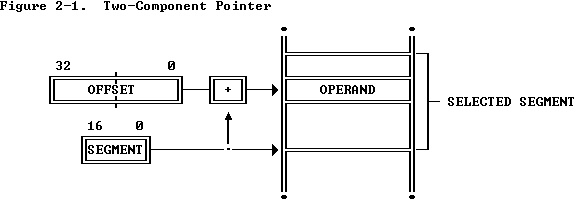2.1 Memory Organization and Segmentation 内存组织和分段
The physical memory of an 80386 system is organized as a sequence of 8-bit bytes. Each byte is assigned a unique address that ranges from zero to a maximum of 2^(32) -1 (4 gigabytes).
80386系统的物理内存被看做8位的流。每一位分配一个唯一的地址,这样就有了从0到最大2^(32)-1(4G)。
80386 programs, however, are independent of the physical address space. This means that programs can be written without knowledge of how much physical memory is available and without knowledge of exactly where in physical memory the instructions and data are located.
然而,80386的程序不依赖于物理地址空间。这意味着程序并不需要知道有多少物理内存可以使用也不需要知道指令和数据被准确地存在放哪些物理内存中。
The model of memory organization seen by applications programmers is determined by systems-software designers. The architecture of the 80386 gives designers the freedom to choose a model for each task. The model of memory organization can range between the following extremes:
程序设计者看到的内存组织模式由操作系统设计者决定。80386的架构给设计者为每个任务选择模式的自由。这种内存组织模式可以导致下列的极端行为:
- A "flat" address space consisting of a single array of up to 4 gigabytes. 一个由4G大小的单个数组来构成的扁平地址空间。
- A segmented address space consisting of a collection of up to 16,383 linear address spaces of up to 4 gigabytes each. 由每4G都是由16383个线性地址空间(最大到4T)集合构成的分段地址空间。
Both models can provide memory protection. Different tasks may employ different models of memory organization. The criteria that designers use to determine a memory organization model and the means that systems programmers use to implement that model are covered in Part -- Programming.
两种模式都可以提供内在保护。不同任务应该有不同的内存组织形式。设计者决定一个内存组织模式的标准和系统程序员实现这些模式的意义将在程序部分涉及。
2.1.1 The "Flat" Model 扁平模式
In a "flat" model of memory organization, the applications programmer sees a single array of up to 2^(32) bytes (4 gigabytes). While the physical memory can contain up to 4 gigabytes, it is usually much smaller; the processor maps the 4 gigabyte flat space onto the physical address space by the address translation mechanisms described in Chapter 5 . Applications programmers do not need to know the details of the mapping.
在扁平的内在组织模式中,应用程序员看到的是一个最大到4G的单个数组。物理内存可以访问到4G大小,但通常没有那么多。处理器映射4G扁平空间到物理地址空间是通过一个在第5章描述的地址转换机制来实现的。应用程序设计人员不需要知道映射细节。
A pointer into this flat address space is a 32-bit ordinal number that may range from 0 to 2^(32) -1. Relocation of separately-compiled modules in this space must be performed by systems software (e.g., linkers, locators, binders, loaders).
扁平地址空间的指针是一个32位的普通数字,其范围为0到2^(32)-1。独立的编译模块对空间的重定位必须由系统软件实现(如:linkers,locators,binders,loaders)。
2.1.2 The Segmented Model 分段模式
In a segmented model of memory organization, the address space as viewed by an applications program (called the logical address space) is a much larger space of up to 2^(46) bytes (64 terabytes). The processor maps the 64 terabyte logical address space onto the physical address space (up to 4 gigabytes ) by the address translation mechanisms described in Chapter 5 . Applications programmers do not need to know the details of this mapping.
在分段的内存组织模式中,应用程序可以看到的地址空间(也叫逻辑地址空间)是一个大到2^(46)字节的空间。处理器通过地址转换机制(第5章会讲到)来映射64T的逻辑地址空间到物理地址空间(最大4G)。应用程序不需要知道映射细节。
Applications programmers view the logical address space of the 80386 as a collection of up to 16,383 one-dimensional subspaces, each with a specified length. Each of these linear subspaces is called a segment. A segment is a unit of contiguous address space. Segment sizes may range from one byte up to a maximum of 2^(32) bytes (4 gigabytes).
应用程序将80386的逻辑地址空间视做一个最大下标为16383的集合,每个项都有相同的指定的长度。每个线性子空间被称作一个段。每个段都是一个连续的地址空间单元。段大小可以从一个字节到最大2^(32)字节(4G)。
A complete pointer in this address space consists of two parts (see Figure 2-1 ):
在这种地址空间下指针由两部分构成(见表2-1):
- A segment selector, which is a 16-bit field that identifies a segment.
一个段选择子,包含16位,表示一个段。
- An offset, which is a 32-bit ordinal that addresses to the byte level within a segment.
一个偏移量,包含32位,表示在段内的位移。

During execution of a program, the processor associates with a segment selector the physical address of the beginning of the segment. Separately compiled modules can be relocated at run time by changing the base address of their segments. The size of a segment is variable; therefore, a segment can be exactly the size of the module it contains.
在执行一个程序时,处理器将一个段选择子和该段的起始物理地址相关联。分享编译的模块可以在运行时通过改变他们的段基址被重新分配。段大小是可变化的;因此,一个段可以是包含的模块的准确大小。